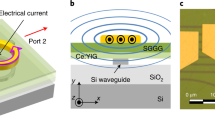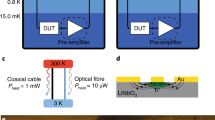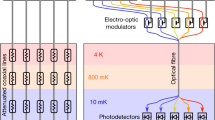Abstract
Broadband, energy-efficient signal transfer between a cryogenic and room-temperature environment has been a major bottleneck for superconducting quantum and classical logic circuits. Photonic links promise to overcome this challenge by offering simultaneous high bandwidth and low thermal load. However, the development of cryogenic electro-optic modulators—a key component for the photonic readout of electrical signals—has been stifled by the stringent requirements of superconducting circuits. Rapid single-flux-quantum circuits, for example, operate with a tiny signal amplitude of only a few millivolts, far below the volt-level signal used in conventional circuits. Here we demonstrate one of the first direct optical readouts of a rapid single-flux-quantum circuit without additional electrical amplification enabled by a novel superconducting electro-optic modulator featuring a record-low half-wave voltage Vπ of 42 mV on a 1-m-long superconducting electro-optic modulator. Leveraging the low ohmic loss of superconductors, we break the fundamental Vπ–bandwidth trade-off and demonstrate an electro-optic bandwidth up to 17 GHz on a 0.2-m-long superconducting electro-optic modulator at cryogenic temperatures. Our work presents a viable solution towards high-bandwidth signal transfer between future large-scale superconducting circuits and room-temperature electronics.
This is a preview of subscription content, access via your institution
Access options
Access Nature and 54 other Nature Portfolio journals
Get Nature+, our best-value online-access subscription
$29.99 / 30 days
cancel any time
Subscribe to this journal
Receive 12 print issues and online access
$209.00 per year
only $17.42 per issue
Buy this article
- Purchase on Springer Link
- Instant access to full article PDF
Prices may be subject to local taxes which are calculated during checkout





Similar content being viewed by others
Data availability
The data that support the findings of this study are included in this Article. Source data are provided with this paper.
Code availability
All relevant computer codes supporting this study are available from the corresponding author upon reasonable request.
References
Devoret, M. H. & Schoelkopf, R. J. Superconducting circuits for quantum information: an outlook. Science 339, 1169–1174 (2013).
Arute, F. et al. Quantum supremacy using a programmable superconducting processor. Nature 574, 505–510 (2019).
Holmes, D. S., Ripple, A. L. & Manheimer, M. A. Energy-efficient superconducting computing—power budgets and requirements. IEEE Trans. Appl. Supercond. 23, 1701610 (2013).
Braginski, A. I. Superconductor electronics: status and outlook. J. Supercond. Nov. Magn. 32, 23–44 (2019).
Das, R. N. et al. Large scale cryogenic integration approach for superconducting high-performance computing. In 2017 IEEE 67th Electronic Components and Technology Conference (ECTC) 675–683 (IEEE, 2017).
Fowler, A. G., Mariantoni, M., Martinis, J. M. & Cleland, A. N. Surface codes: towards practical large-scale quantum computation. Phys. Rev. A 86, 032324 (2012).
Krinner, S. et al. Engineering cryogenic setups for 100-qubit scale superconducting circuit systems. EPJ Quantum Technol. 6, 2 (2019).
Lecocq, F. et al. Control and readout of a superconducting qubit using a photonic link. Nature 591, 575–579 (2021).
Youssefi, A. et al. A cryogenic electro-optic interconnect for superconducting devices. Nat. Electron. 4, 326–332 (2021).
de Cea, M. et al. Photonic readout of superconducting nanowire single photon counting detectors. Sci. Rep. 10, 9470 (2020).
Han, X., Fu, W., Zou, C.-L., Jiang, L. & Tang, H. X. Microwave-optical quantum frequency conversion. Optica 8, 1050–1064 (2021).
Miller, D. A. B. Attojoule optoelectronics for low-energy information processing and communications. J. Light. Technol. 35, 346–396 (2017).
Kachris, C. & Tomkos, I. A survey on optical interconnects for data centers. IEEE Commun. Surveys Tuts 14, 1021–1036 (2012).
Winzer, P. J., Neilson, D. T. & Chraplyvy, A. R. Fiber-optic transmission and networking: the previous 20 and the next 20 years [invited]. Opt. Express 26, 24190–24239 (2018).
Mukhanov, O. A. et al. Superconductor digital-RF receiver systems. IEICE Trans. Electron. E91-C, 306–317 (2008).
Mukhanov, O. A. Energy-efficient single flux quantum technology. IEEE Trans. Appl. Supercond. 21, 760–769 (2011).
McDermott, R. et al. Quantum-classical interface based on single flux quantum digital logic. Quantum Sci. Technol. 3, 024004 (2018).
Likharev, K. & Semenov, V. RSFQ logic/memory family: a new Josephson-junction technology for sub-terahertz-clock-frequency digital systems. IEEE Trans. Appl. Supercond 1, 3–28 (1991).
Gupta, D. et al. Digital output data links from superconductor integrated circuits. IEEE Trans. Appl. Supercond. 29, 1–8 (2019).
Fu, W., Wu, H. & Feng, M. Superconducting processor modulated VCSELs for 4K high-speed optical data link. IEEE J. Quantum Electron. 58, 1–8 (2022).
Lambert, N. J., Rueda, A., Sedlmeir, F. & Schwefel, H. G. L. Coherent conversion between microwave and optical photons—an overview of physical implementations. Adv. Quantum Technol. 3, 1900077 (2020).
Delaney, R. D. et al. Superconducting-qubit readout via low-backaction electro-optic transduction. Nature 606, 489–493 (2022).
Usami, K. & Nakamura, Y. A photonic link for quantum circuits. Nat. Electron. 4, 323–324 (2021).
Gehl, M. et al. Operation of high-speed silicon photonic micro-disk modulators at cryogenic temperatures. Optica 4, 374–382 (2017).
Eltes, F. et al. An integrated optical modulator operating at cryogenic temperatures. Nat. Mater. 19, 1164–1168 (2020).
Chakraborty, U. et al. Cryogenic operation of silicon photonic modulators based on the d.c. Kerr effect. Optica 7, 1385–1390 (2020).
Lee, B. S. et al. High-performance integrated graphene electro-optic modulator at cryogenic temperature. Nanophotonics 10, 99–104 (2020).
Yin, B. et al. Electronic-photonic cryogenic egress link. In ESSCIRC 2021—IEEE 47th European Solid State Circuits Conference (ESSCIRC) 51–54 (IEEE, 2021).
Pintus, P. et al. An integrated magneto-optic modulator for cryogenic applications. Nat. Electron. 5, 604–610 (2022).
Pintus, P. et al. Ultralow voltage, high-speed, and energy-efficient cryogenic electro-optic modulator. Optica 9, 1176–1182 (2022).
Xiong, C., Pernice, W. H. P. & Tang, H. X. Low-loss, silicon integrated, aluminum nitride photonic circuits and their use for electro-optic signal processing. Nano Lett. 12, 3562–3568 (2012).
Wooten, E. L. et al. A review of lithium niobate modulators for fiber-optic communications systems. IEEE J. Sel. Topics Quantum Electron 6, 69–82 (2000).
Herzog, C., Poberaj, G. & Günter, P. Electro-optic behavior of lithium niobate at cryogenic temperatures. Opt. Commun. 281, 793–796 (2008).
Lomonte, E. et al. Single-photon detection and cryogenic reconfigurability in lithium niobate nanophotonic circuits. Nat. Commun. 12, 6847 (2021).
Wang, C. et al. Integrated lithium niobate electro-optic modulators operating at CMOS-compatible voltages. Nature 562, 101–104 (2018).
Zhang, M., Wang, C., Kharel, P., Zhu, D. & Lončar, M. Integrated lithium niobate electro-optic modulators: when performance meets scalability. Optica 8, 652–667 (2021).
Yoshida, K., Kanda, Y. & Kohjiro, S. A traveling-wave-type LiNbO/sub 3/ optical modulator with superconducting electrodes. IEEE Trans. Microw. Theory Techn. 47, 1201–1205 (1999).
Thiele, F. et al. Cryogenic electro-optic modulation in titanium in-diffused lithium niobate waveguides. J. Phys. Photonics 4, 034004 (2022).
Baker, J. W., Lejeune, J. D. & Naugle, D. G. Effects of a nonuniform current distribution on the kinetic inductance of a thin superconducting film. J. Appl. Phys. 45, 5043–5049 (1974).
Tinkham, M. Introduction to Superconductivity (Courier Corporation, 2004).
Tolpygo, S. et al. Advanced fabrication processes for superconducting very large scale integrated circuits. In IEEE Trans. Appl. Supercond. 26, 1100110 (2016).
Freude, W. et al. Quality metrics for optical signals: eye diagram, Q-factor, OSNR, EVM and BER. In 2012 14th International Conference on Transparent Optical Networks (ICTON) 1–4 (IEEE, 2012).
Agrell, E. & Secondini, M. Information-theoretic tools for optical communications engineers. In 2018 IEEE Photonics Conference 1–5 (IEEE, 2018).
Chang, D. et al. LDPC convolutional codes using layered decoding algorithm for high speed coherent optical transmission. In Optical Fiber Communication (OFC) Conference 1–3 (IEEE, 2012).
Zhang, M., Wang, C., Cheng, R., Shams-Ansari, A. & Lončar, M. Monolithic ultra-high-Q lithium niobate microring resonator. Optica 4, 1536–1537 (2017).
Acknowledgements
This project was funded by IARPA’s SuperCables program through the ARO grant W911-NF-19-2-0115, and DOE Office of Science, National Quantum Information Science Research Centers, Co-design Center for Quantum Advantage (C2QA), contract no. DE-SC0012704. We thank the Office of Naval Research for providing funding support in the construction of the RF interface through grant N00014-20-1-2134. Y.Z. acknowledges support from the Yale Quantum Institute. We extend our gratitude to B. Liu for his assistance with the RSFQ circuit module installation and operation. We would also like to acknowledge HYPRES for their contributions to the RSFQ circuit design and for granting permission to use the micrograph of the RSFQ circuit chip in this Article. Special thanks go to D. Kirichenko and D. Gupta for their insightful discussions. We are grateful to M. Gehl, B. Palmer, S. Nam, D. V. Vecheten, W. Mayer and W. Harrod for providing valuable technical and administrative support throughout this project. Finally, we thank Y. Sun, S. Rinehart, L. McCabe, K. Woods and M. Rooks for assistance in the device fabrication.
Author information
Authors and Affiliations
Contributions
H.X.T. and M.S. conceived the idea and experiment. M.S. fabricated the device and performed the experiment. J.X. and Y.X. helped with the fabrication and experiments. S.W., R.C., W.F. and Y.Z. helped with the device packaging and instrumentation. M.S. wrote the manuscript, and all authors contributed to the manuscript. H.X.T. supervised the work.
Corresponding author
Ethics declarations
Competing interests
The authors declare no competing interests.
Peer review
Peer review information
Nature Photonics thanks Paolo Pintus and the other, anonymous, reviewer(s) for their contribution to the peer review of this work.
Additional information
Publisher’s note Springer Nature remains neutral with regard to jurisdictional claims in published maps and institutional affiliations.
Supplementary information
Supplementary Information
Supplementary Figs. 1–14 and Sections I–X.
Rights and permissions
Springer Nature or its licensor (e.g. a society or other partner) holds exclusive rights to this article under a publishing agreement with the author(s) or other rightsholder(s); author self-archiving of the accepted manuscript version of this article is solely governed by the terms of such publishing agreement and applicable law.
About this article
Cite this article
Shen, M., Xie, J., Xu, Y. et al. Photonic link from single-flux-quantum circuits to room temperature. Nat. Photon. 18, 371–378 (2024). https://doi.org/10.1038/s41566-023-01370-2
Received:
Accepted:
Published:
Issue Date:
DOI: https://doi.org/10.1038/s41566-023-01370-2
This article is cited by
-
Cryogenic optical data link for superconducting circuits
Nature Photonics (2024)



